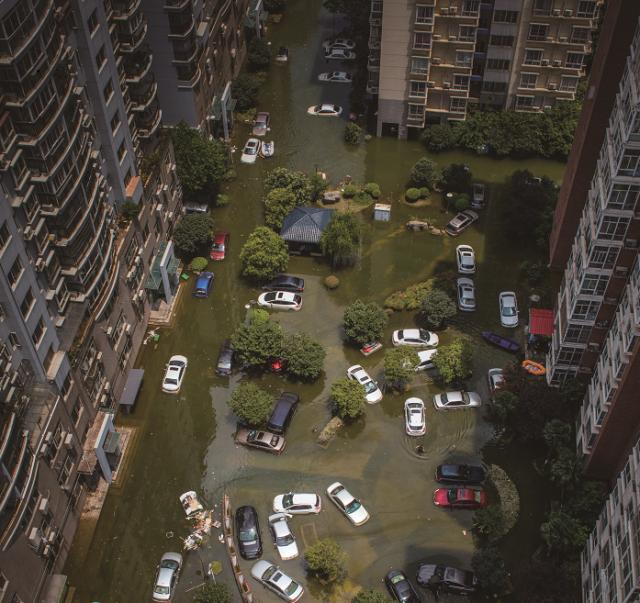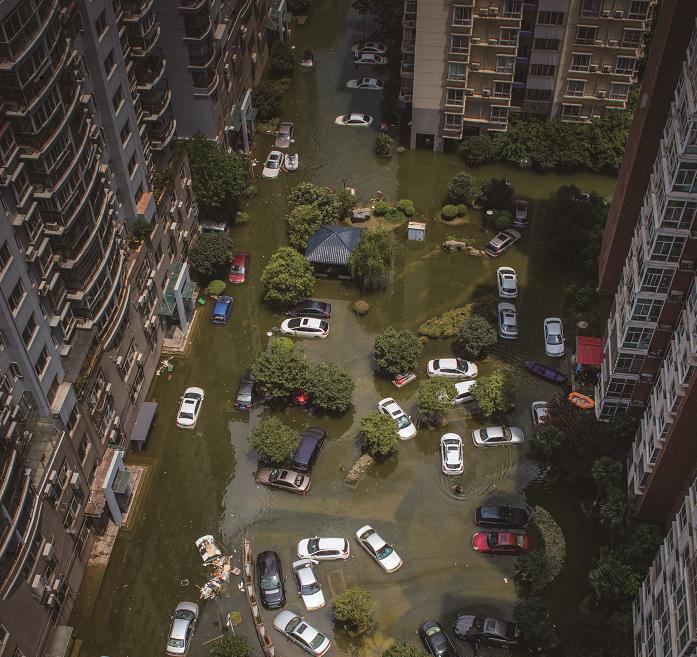The catastrophic flooding in Wuhan has called into question the efficacy of the city’s huge expenditure on drainage while draining its lakes for real estate projects

A community remains besieged by flood water several days after heavy rain, Wuhan, Hubei Province, July 10, 2016 / Photo by IC
On the morning of July 6, thousands woke to find themselves trapped in their homes in Wuhan, the capital of Hubei Province and a sprawling metropolis on the Yangtze River. According to the Wuhan Water Authority (WWA), the city received up to 588 millimeters of precipitation on that day alone, one of the city’s heaviest recorded rainstorms.
At 4 AM the next day, workers at the flood control department of the water authority had their eyes fixed on the vast screen monitoring meteorological data in the region, but the rain showed no sign of ebbing.
“The wolf has finally arrived,” said Wang Chibing, head of the WWA sewage department. Wang told NewsChina that he was not worried about the city’s embankments because they had been shored up many times after a heavy flood hit the city in 1998. What he worried about most was water overloading the city’s drainage system. His fears were justified. On that drenched July day, 162 areas across the city were inundated.
Investment
The urban flooding across swaths of Wuhan sparked heated discussion online as many people queried the efficacy of the government’s apparently huge expenditure on the city’s drainage system.
In 2013, Wuhan began constructing a massive urban drainage system budgeted at over 13.2 billion yuan (US$2bn), with planners focusing on building 17 complete drainage networks. The municipal government’s 2014 work report stated that, in 2013, workers laid 115 kilometers of new underground pipes, and renovated a further 4,000 kilometers of existing piping, along with drainage systems in 20 residential communities previously affected by waterlogging.
In a report by State broadcaster CCTV, however, WWA officials revealed that to date only 4 billion yuan (US$600m) had actually been spent on the city’s drainage project because construction had routinely been halted to settle disputes over compensation for local residents displaced by the public works project.
Even though the drainage project has yet to be finished, local residents who spoke to NewsChina said that drainage in Wuhan, a city accustomed to flooding, was already performing better than it had in the past. A resident surnamed Xiao told our reporter that the improved drainage systems have a positive effect during the latest round of flooding, claiming that “the water receded much faster than in 1998.”
The floods of 1998 have left an indelible and painful scar on Wuhan’s collective memory – entire urban areas of the city were inundated. In the wake of the disaster, the city started a massive campaign to build flood defenses and, by the end of 2002, 397 kilometers of embankments were built and shored up. In 2002, the WWA was officially established to comprehensively deal with the city’s water supply, sewage treatment and flood prevention.
In Wang’s opinion, it is much more difficult to maintain embankments and drainage pipes than to construct new ones. “Which is easier: to decorate a new house, or renovate an old one?” He asked.
According to the WWA, by the end of 2014, Wuhan’s urban areas housed a total of 22 drainage systems with a catchment area of 1,798 square kilometers, supported by 38 pumping stations with a total sewage flow capacity of 958 cubic meters of water per second. In
2015, 109 kilometers of drainage pipes were added to this network.
In 2013, according to official data, 54 areas of the city experienced flooding, down from 88 in 2011. In 2016, the WWA invested 100 million yuan (US$15m) in an integrated information management platform which could detect changes in the water table and in the city’s lakes, reservoirs and waterways. The same system provided information on rainfall, pumping station activity and flooding.

Workers maintain and fuel pumps that draw flood water around the clock, Wuhan, Hubei Province, July 11, 2016 / Photo by IC
Lakes
After the flood hit Wuhan, some experts warned that the city had reclaimed too many of its lakes in order to accommodate construction projects, significantly affecting the city’s natural water storage capacity. Official statistics showed that since the early 1950s, the number of lakes situated in urban areas of Wuhan dropped from 127 to 40.
Wang, however, disagreed with such claims, saying that the reclamation of lakes had not occurred in recent years, with the bulk reclaimed in the 1960s to clear land for agriculture, a common nationwide practice at the time.
“[Back then] the general public found it hard to fill their empty stomachs and had to plant crops after the lakes were reclaimed,” he said.
He admitted that there had been a minor decline in the city’s total lake area in the 1990s, but insisted that the decline was small and only involved the smallest lakes. In 2002, Wuhan released regulations designed to protect its remaining lakes, the first such initiative launched in China.
“Since 2002, there are 166 lakes in Wuhan, including more than 40 in urban areas, and not one has disappeared to this day,” said Wang.
Shi Nan, secretary general of the China Association of City Planning, told NewsChina that, from a city planning perspective, lake reclamation has always been off limits. Several years ago, he said, his office made a public appeal to try to stop districts and counties in Wuhan from illegally reclaiming their lakes.
Lake protection regulations in Wuhan were updated last year and the boundaries of existing protection zones surrounding the city’s 166 lakes were all clearly defined. Illegal reclamation and construction projects undertaken within these zones were made liable for fines of 500,000 yuan (US$75,000).
“If a lake has to be reclaimed for urban construction, regulations require that another lake has to be created in close proximity,” Wang said, adding that the WWA established a new department in 2009 that is responsible for the examination and approval of construction projects in lake areas. To this day, he said, no applications have been approved.

About 12,000 villagers, including this five-year old boy, were evacuated from their flood-hit homes and settled in other towns, Wuhan, Hubei Province, July 9, 2016 / Photo by IC
Drainage
Since late April, the WWA has been pumping water from the city’s lakes into the Yangtze River, trying to avert urban flooding caused by these bodies of water bursting their banks. Before the rainstorms in early July, Wang said, the WWA spent 150 days clearing all 5,800 drainage pipes in the city.
“Without these preparations, the aftermath of the flood would have been unimaginable,” he told NewsChina. “I have never seen such torrential rain in my life.”
According to the Yangtze River Flood Control and Drought Relief Headquarters, the flooding has affected 49 million residents along the Yangtze River and its tributaries, with 2.9 million people evacuated this year, resulting in economic losses of 103 billion yuan (US$15.4bn), mostly incurred since June 30, when the deluge began. The Hubei provincial government issued a statement claiming that, as of July 6, torrential rain, flooding and associated landslides in the province had left 61 people dead and 24 missing.
Official data indicate that the water table in Wuhan reached 29.73 meters in 1954, the highest level ever recorded on the Yangtze River and also the safety cutoff level for the city. The heavy rains on July 6 brought the city’s water table to 28.37 meters.
During a press conference organized by the WWA on July 6, the agency said that the current construction criteria for drainage systems in Wuhan were relatively low – pipe networks had to be able to withstand 100 millimeters of rainfall within 24 hours, and 34.5 millimeters of rainfall within one hour. Flooding, Wang told NewsChina, is inevitable once these limits are exceeded. Indeed, our reporter noted that the worst flooding in the city occurred not in older areas, but in newly built residential communities, where the waters failed to recede for days.
Shi Nan said that the infrastructure in old residential areas is inferior to that in newer areas, indicating that the flooding affecting supposedly pristine new communities represents a problem with “construction management rather than city planning.”
“The [extent of the] flooding was because of construction practices. Many real estate developers give priority to grabbing up new projects, and pay little attention to the drainage system. They excavate their own drains, changing geomorphology and exacerbating [the problem of] poor drainage in the surrounding areas,” Shi added.

 Old Version
Old Version


